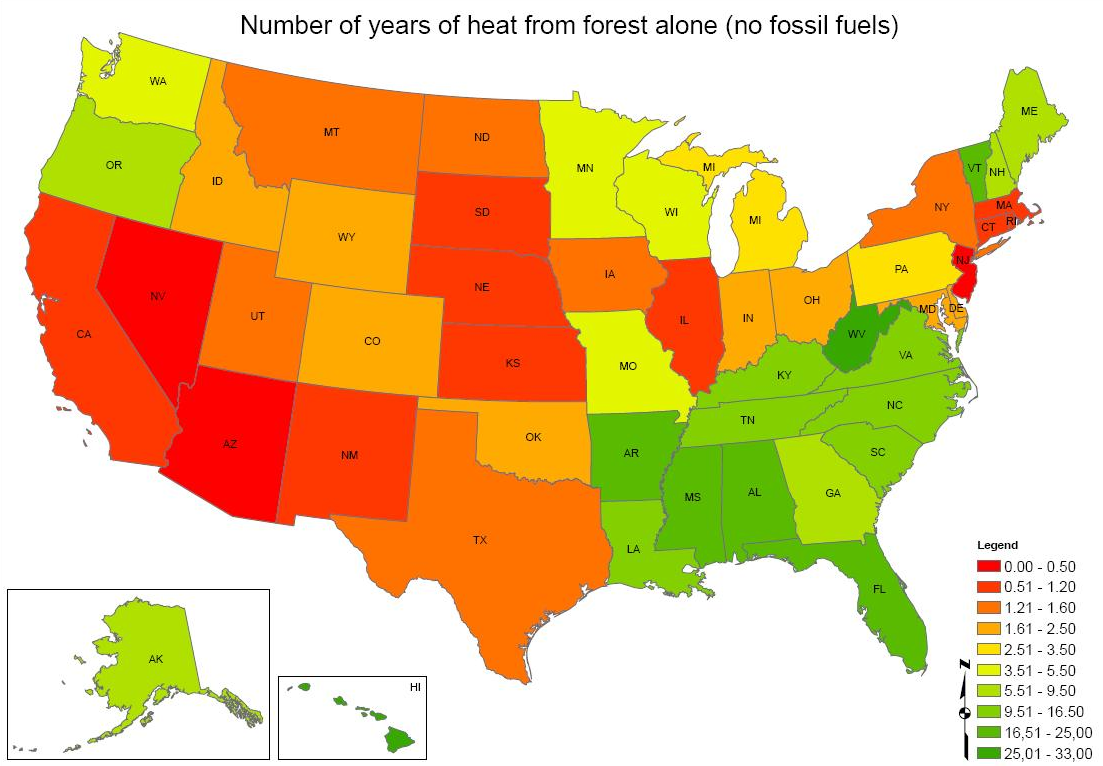
Preface. Just when civilization is decades from returning to wood as the main energy source (due to peak oil in 2018), climate change is allowing invasive beetles to survive winters and kill trees, with drought and wildfires increasing the damage.
Although the high prices of wood in 2021 are being blamed on inflation, the true cause is drought, invasive beetles, climate change, and wildfires. In the U.S., as the first article shows, a main reason is tree dieoff in Canada.
After that are a lot of statistics to get an idea of how wood stacks up against other energy resources. Burning wood to heat U.S. homes is about 1% of fuel used to directly heat buildings, with 50-66% of this wood being burned in wood stoves rather than fireplaces (USDOE 2008).
In 2014, about 2.5 million households (2.1%) across the country used wood as the main fuel for home heating, up from 1.9 million households (1.7%) in 2005. An additional 9 million households (7.7%) use wood as a secondary heating fuel. This combination of main and secondary heating accounts for about 500 trillion British thermal units (Btu) of wood consumption per year in the residential sector, or about the same as propane consumption and slightly less than fuel oil consumption (U.S. EIA March 17, 2014 Increase in wood as main source of household heating most notable in the Northeast).
Alice Friedemann www.energyskeptic.com Author of Life After Fossil Fuels: A Reality Check on Alternative Energy; When Trucks Stop Running: Energy and the Future of Transportation”, Barriers to Making Algal Biofuels, & “Crunch! Whole Grain Artisan Chips and Crackers”. Women in ecology Podcasts: WGBH, Jore, Planet: Critical, Crazy Town, Collapse Chronicles, Derrick Jensen, Practical Prepping, Kunstler 253 &278, Peak Prosperity, Index of best energyskeptic posts
***
Meyer R (2021) Why Dead Trees Are ‘the Hottest Commodity on the Planet’. The Atlantic.
This shows how many years it would take to deplete forests in each state if wood alone were used for heat. Source: Nate Hagens 2007 oildrum post “Old Sunlight vs Ancient Sunlight -An Analysis of Home Heating and Wood” which he derived from many other sources.
***
Wood takes up about 5 times as much space as coal for the same amount of BTU’s generated. Coal and wood come with different energy densities, so this is a very rough estimate.
Energy Content of Fuels: just part of Energy Fun Facts table
Coal 25 million BTU/ton 2,103 lbs to 2,243 lbs = 1 cubic yard
Crude Oil 5.6 million BTU/barrel
Oil 5.78 million BTU/barrel = 1700 kWh / barrel
Gasoline 5.6 million BTU/barrel (a barrel is 42 gallons) = 1.33 therms / gallon
Natural gas liquids 4.2 million BTU/barrel
Natural gas 1030 BTU/cubic foot
Wood 20 million BTU/cord 8 x 4 x 4 feet = 128 cubic feet = 4.7 cubic yards
Source: http://www.physics.uci.edu/~silverma/units.html
wiki: One seasoned (dry) cord of red oak has the heating equivalent of 108 US gallons
Nate Hagens. Home Heating in the USA: A Comparison of Forests with Fossil Fuels. theoildrum
USDOE 2008. U.S. Department of Energy, Office of Energy Efficiency and Renewable Energy. 2008 Buildings Energy Data Book buildingsdatabook.eere.energy.gov/.
THE ENERGY IN WOOD
Freshly cut wood has over 60% moisture and therefore takes much more effort to release the energy in the wood fibers. Seasoned wood approaches 20% moisture content and releases about 6,400 BTUs per pound of wood. (Pure bone-dry wood tops 8,000 BTUs per pound but is not practical for home use). Almost all wood types create the same amount of BTUs per pound (6,400), but depending on their individual densities and other properties, differ in how many pounds make up 1 cord. Some examples are:
Hickory => 4,327 lbs per cord => 27.7 million BTUs per cord
Red Maple => 2,924 lbs per cord => 18.7 million BTUs per cord
Cottonwood => 2,108 lbs per cord => 13.5 million BTUs per cord
Cedar => 1,913 lbs per cord => 12.2 million BTUs per cord
A complete list of wood types and BTU content per cord can be found here
This analysis assumes one cord of wood typically is about 2400 pounds. We then arrive at 2,400 X 6,400 BTUs =15,360,000 BTUs per cord. Therefore, in the 52 US states, we have 34.7 million cords of annual volume growth of wood available times 15.36 million BTUs per cord => 533 Trillion BTUs that can be presently be accessed sustainably from hardwoods. (If we eschew all other forest products, this number roughly doubles, and if we include softwoods, it roughly doubles again)
PUTTING THE PIECES TOGETHER
Heating with wood is not as efficient as heating with natural gas or #2 heating oil. A significant portion of the heat generated from burning escapes up the flue to dissipate as heat in the atmosphere. Wood stoves and furnaces average about 55% efficiency. This compares to 85% efficiency for natural gas furnaces and 80% for furnaces using #2 heating oil or kerosene. (the lower the efficiency rating the more BTUs of heat is ‘lost’ and unable to provide heat to targeted areas).
So, of the 5,030 trillion BTUs generated by natural gas furnaces in 2004, 85% or 4,275 trillion BTUs went directly to heating, and 15%, or 755 trillion BTUs was dissipated as waste heat. Similarly, of the 998 trillion BTUs generated by heating oil, roughly 80%, or 799 trillion BTUs went directly to heating.
Of the 532 Trillion BTUs that could be generated annually from forest growth, approximately 55% or 297 Trillion BTUs would end up as ‘actual heat’. Natural Gas and Heating Oils collectively generated 5,074 Trillion BTUs of ‘actual heat’. Thus, this analysis indicates that we could sustainably replace 297 / 5,074 Trillion BTUs or 5.8% of fossil fuel home heating use with home heating from wood. Alternatively, the entire United States forest stock of hardwoods contains 364 billion cubic feet of wood, or 2.84 billion cords which would throw off 24,024 Trillion BTUs (note, this is only 24% of the total annual energy usage of the country). So the good news is if we were really cold and sans fossil fuels, we could chop down trees for at least 4 years before the US would resemble Easter Island (24,024/5,074= 4.74 years). On a state by state basis, the distribution would look like the following:
What’s a British Thermal Unit (Btu)?
1 Btu = 1000 joules = 1 match tip = amount of energy to raise temperature of 1 pint of water 1 degree Fahrenheit
4 Btus = 1 food calorie
36 Btus = 9 calories = energy expended by the average female jogging for 1 minute
70 Btus = energy to make 1 cup of coffee
2,455 Btus = energy required for 1 horsepower for one hour
7,200 Btus = minimum average energy requirement per person = 1,800 calories
11,000 Btus = 1 lb of coal
16,000 Btus = energy in 1 lb of fat
125,000 Btus = 1 gallon of gasoline
149,000 Btus = 1 gallon of heating oil, diesel fuel, or jet fuel (JP 4)
840,000 Btus = energy in 1 cubic foot of coal
995,000 Btus = energy in 1 cubic foot of crude oil
1,000,000 Btus = 90 pounds of coal = 8 gallons of gasoline
22,000,000 Btus = 1 cord of wood (8 x 4 x 4 feet) about 1.5 to 2 tons typically
36,000,000 Btus = electricity used by the average American in a year
104,000,000 Btus = yearly residential energy use of average U.S. household
323,000,000 Btus = per person energy consumption in the U.S. = 54 barrels of oil
1,000,000,000 Btus = electricity used by 30 average Americans in a year = 47 cords of wood
100,000,000,000 Btus = electricity used by 3,000 average Americans in a year
1,000,000,000,000 Btus = energy contained in 450 railroad cars of coal (100 tons each)
= train 4 1/4 miles long
= 8 million gallons of gas = 166,000 barrels of crude oil
= enough energy to heat 20,000 single family homes per year in the U.S.
5 trillion Btus = enough energy to heat 100,000 single family homes per year in the U.S.
7.3 trillion Btus = amount of oil being carried by the Exxon Valdez when its oil spill occurred
36 trillion Btus = yearly electricity consumption of all Arkansas residences
135 trillion Btus = energy use by all residential dishwashers in the U.S. for one year
734 trillion Btus = energy generated for residential TV viewing
1 quadrillion Btus = 1,000,000,000,000,000 Btus
= 170 million barrels of crude oil
= 60 million tons of dried wood
= 19 days of U.S. petroleum imports
= 25 days of U.S. motor gasoline use
= 25 hours of world energy use (1990)
= fill a football field 3.7 miles high with oil
= 450,000 railroad coal cars (100 tons each)
= train 4,300 miles long (from New York to San Francisco and half way back)
1.4 quadrillion Btus = energy used by all residential air conditioning in the U.S. for one year
= energy used by all residential refrigeration in the U.S. for one year
5 quadrillion Btus = total energy consumed by U.S. chemical industry yearly
= 850 million barrels of crude oil
= enough oil to fill 83 Sears Towers
= 225 million tons of coal
= energy used by all residential appliances in the U.S. for one year
33 quadrillion Btus = total energy consumed by U.S. industry yearly
= 5.6 billion barrels of crude oil
= enough oil to fill 550 Sears Towers
= fill 1,400 of the world’s largest supertankers
= 1.5 billion tons of coal
88 quadrillion Btus = total energy consumed in U.S. yearly
= 15 billion barrels of crude oil
= enough oil to cover a soccer field 230 miles deep
= fill 3,700 of the world’s largest supertankers
= 4 billion tons of coal
= 40 million railroad cars of coal (100 tons each)
= coal train long enough to reach to the moon and half way back
363 quadrillion Btus = worldwide energy production, 1995
Source: Energy Fun Facts. Energy, Environmental, and Economics (E3) Handbook Appendix F. U.S. Department of Energy EERE industrial technologies program.
Common Heating Fuels and their Energy Content (From PG&E)
| Energy Source | Unit | Energy Content (Btu) |
|---|---|---|
| Electricity | 1 Kilowatt-hour | 3412 |
| Butane | 1 Cubic Foot (cu.ft.) | 3200 |
| Coal | 1 Ton | 28,000,000 |
| Crude Oil | 1 Barrel – 42 gallons | 5,800,000 |
| Fuel Oil no.1 | 1 Gallon | 137,400 |
| Fuel Oil no.2 | 1 Gallon | 139600 |
| Fuel Oil no.3 | 1 Gallon | 141800 |
| Fuel Oil no.4 | 1 Gallon | 145100 |
| Fuel Oil no.5 | 1 Gallon | 148800 |
| Fuel Oil no.6 | 1 Gallon | 152400 |
| Diesel Fuel | 1 Gallon | 139,000 |
| Gasoline | 1 Gallon | 124,000 |
| Natural Gas | 1 Cubic Foot (cu.ft.) | 950 – 1150 |
| Heating Oil | 1 Gallon | 139,000 |
| Kerosene | 1 Gallon | 135,000 |
| Pellets | 1 Ton | 16,500,000 |
| Propane | 1 Gallon | 91,330 |
| Propane | 1 Cubic Foot (cu.ft.) | 2,550 |
| Residual Fuel Oil 1) | 1 Barrel – 42 gallons | 6,287,000 |
| Wood – air dried | 1 Cord | 20,000,000 |
| Wood – air dried | 1 pound | 8000 |

